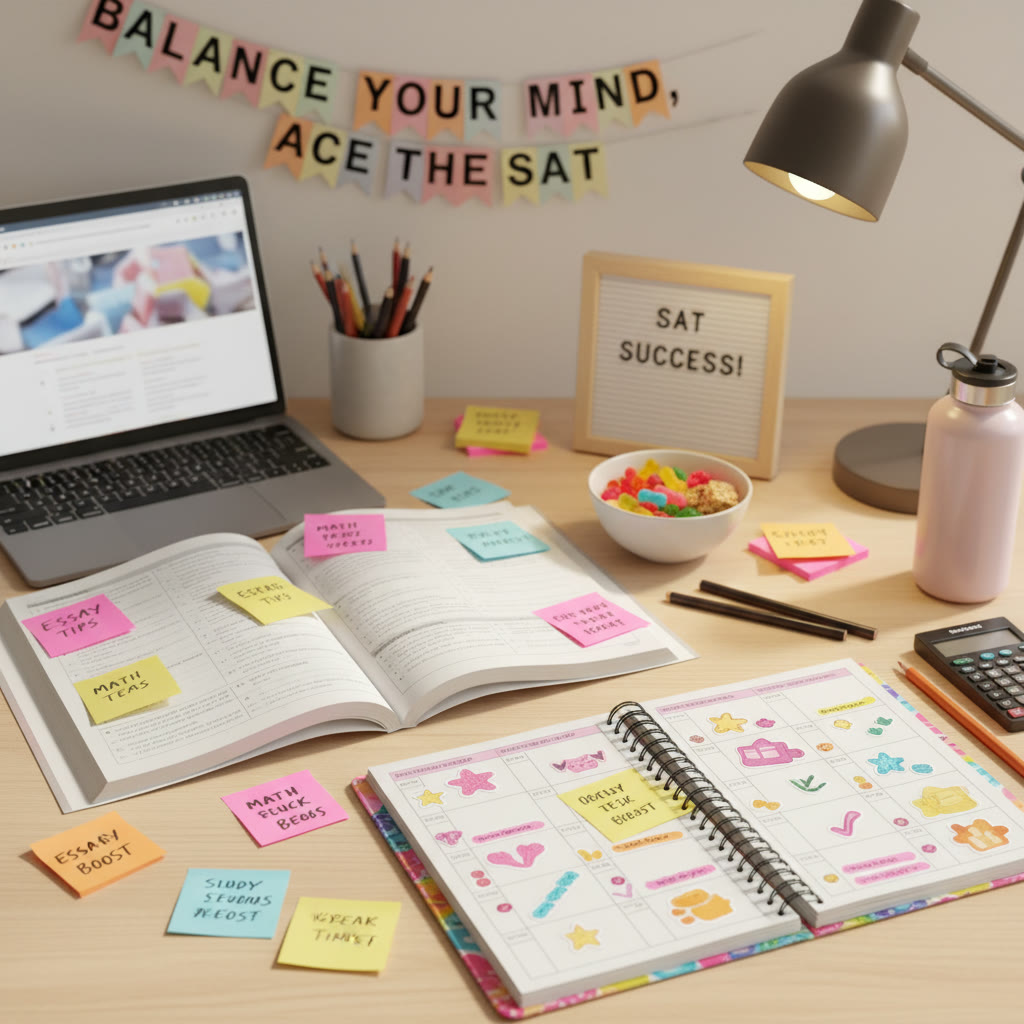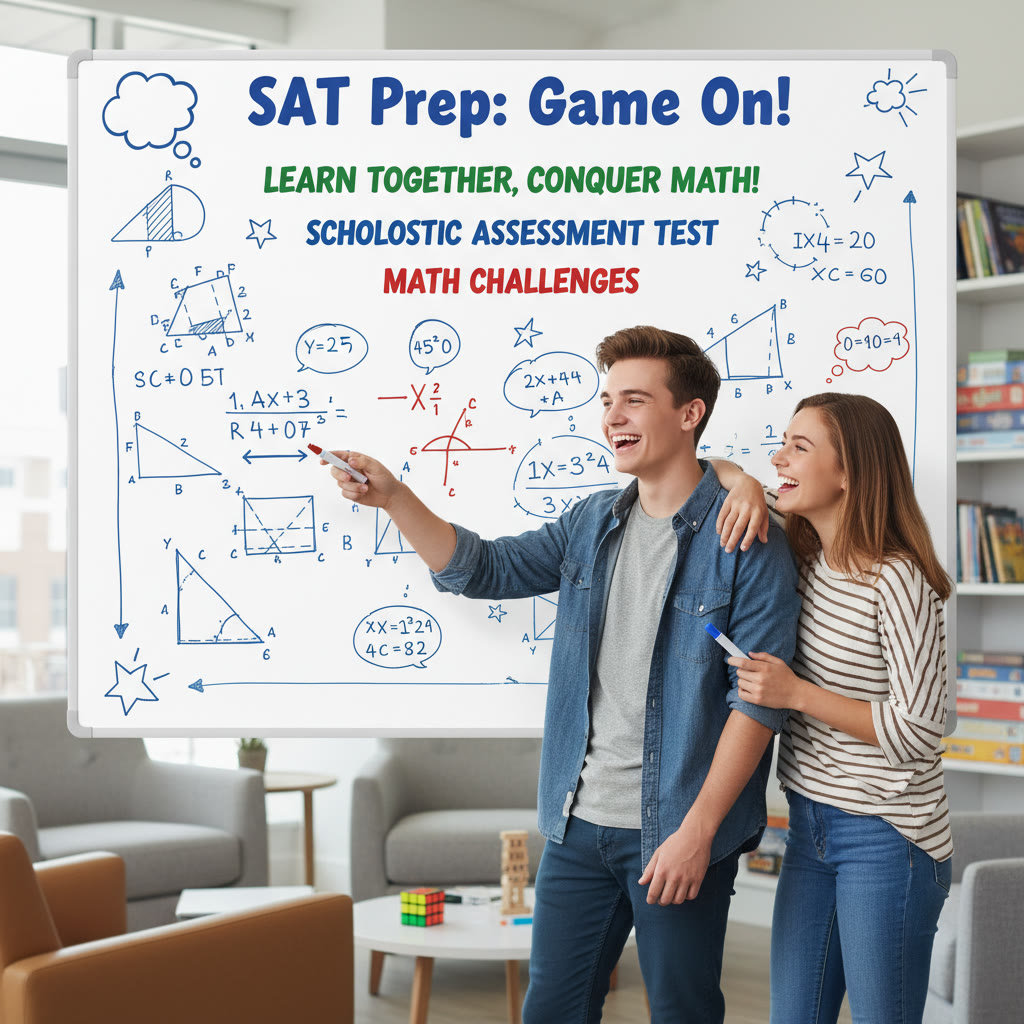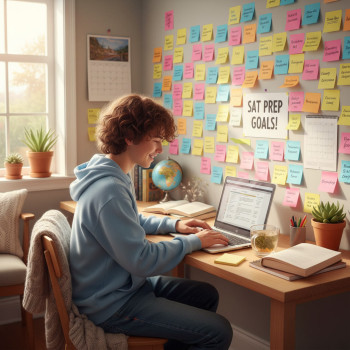Why ‘fun’ belongs in serious SAT prep
If the phrase “study hard” conjures an image of a student chained to a desk with a pile of practice tests, you’re not alone. SAT prep often becomes an endurance sport: long hours, heavy content, and that creeping, demoralizing fog called burnout. But here’s a secret many top students discover: adding deliberate, small doses of fun doesn’t make you lazy — it makes you smarter. It keeps motivation high, improves memory, and helps you actually enjoy the grind.
This post walks through why fun works, how to design study blocks that mix enjoyment with effective techniques, and gives concrete schedules and examples you can try tomorrow. I’ll also touch on how Sparkl’s personalized tutoring and benefits like 1-on-1 guidance, tailored study plans, expert tutors, and AI-driven insights can naturally fit into a fun—and effective—prep routine.
What burnout looks like (and why it matters)
Burnout isn’t just feeling tired. In study terms, it shows up as:
- Fading focus: the same paragraph takes twice as long to read.
- Plateaus and dips: practice test scores stall or swing unpredictably.
- Low motivation: you skip sessions you used to enjoy.
- Negative spiral: missed sessions lead to anxiety, which leads to more missed sessions.
On a cognitive level, chronic stress impairs working memory and retrieval — the exact skills you need on test day. So preventing burnout is not indulgence; it’s strategy.
The science-friendly case for mixing fun with focused study
Let’s be practical: your brain likes novelty and reward. When you pair effortful study with small, enjoyable rewards, you get better long-term motivation. The principles below are well-supported by learning science and simple experimentation.
Active recall + spaced repetition, with rewards
Active recall (testing yourself) and spaced repetition (spacing reviews over time) are heavy-hitters for retention. But they can feel repetitive. By pairing short recall sessions with small enjoyable activities — a 10-minute walk, a quick guitar riff, a snack you love — you maintain momentum and reduce dread. Over time, your brain starts to associate productive effort with a predictable reward loop.
Variety combats monotony
Variety isn’t just pleasant; it helps memory by creating more contextual cues. If you always study vocabulary the same way — flashcards in the same room at the same time — recall can become context-dependent. Mix locations, formats (audio, quiz, writing), and even little rituals to make memories richer.
Movement boosts attention
Short bouts of physical activity — a 5-minute jog, dynamic stretches, or a dance break — increase blood flow and arousal. That often translates into sharper attention for the next study block. Studies show even modest exercise helps learning and mood; no need to run a marathon, just move.
Practical ways to inject fun into your SAT prep
Below are concrete techniques to brighten your days without sacrificing rigor. Think of them as tools you can tweak by mood, topic, or how close you are to test day.
1. Build a “fun-first” microstructure
Start sessions by promising yourself a short enjoyable reward after the work block. Example: “Two 25-minute problem sets, then 15 minutes of sketching.” The trick is discipline: keep the study block focused so the reward feels earned.
- Micro-rewards: coffee, a chapter of a favorite book, 10 minutes of a game.
- Macro-rewards: a night out, an episode of a TV show, or a hobby project after a milestone.
2. Use the Pomodoro—but personalize it
The classic Pomodoro is 25 minutes of focused work followed by 5 minutes of break, with a longer break after four cycles. That works well for many students. But don’t be rigid. Try:
- 50/10 for deeper math work.
- 15/3 for heavy reading days.
- Mix-and-match: 25 minutes of practice problems, 10 minutes of guitar or drawing.
During short breaks, do something that refreshes, not drains: a quick stretch, a snack, or a five-minute outside step. Avoid doom-scrolling; leisure should restore attention.
3. Theme days and mini-projects
Create one or two days a week with an upbeat theme to change pace. Examples:
- “Puzzle Saturday” — solve challenging math puzzles and logic games.
- “Story Sunday” — practice reading passages by mapping arguments, then write short summaries and share them with a study buddy.
- “Grammar Game Night” — challenge a friend to spot and fix errors for points.
These themes turn tedium into a story. You’ll remember concepts better when they’re tied to activities you enjoy.
4. Make practice tests less dreadful
Full-length tests are essential, but they can feel punishing. Try scaffolded test prep:
- Week 1: Two 1.5- to 2-hour sections (focus on strategy, not endurance).
- Week 2: One full test, but schedule a relaxing activity afterwards: pizza with friends, a hike, or a creative evening.
- Alternate: simulate test conditions once every 10–14 days, and use lighter practice the rest of the time.
Rewarding yourself after a full test builds a healthier emotional association with the experience.
5. Gamify progress
Create a points system. Earn points for completing practice sets, reviewing flashcards, or hitting a streak. Trade points for privileges (movie night, dessert, time off). The novelty of gamification can breathe life into repetitive tasks.
6. Bring friends in—social learning
Group study, when done intentionally, can boost motivation and deepen understanding. Make it structured: 40 minutes focused work followed by 20 minutes of collaborative review, problem exchange, or mini-competitions. Friendly social accountability keeps you going on low-energy days.
7. Pair study with movement
Try flashcards while walking, or listen to Reading practice passages while on a treadmill at a comfortable pace. Short, high-quality movement enhances mood and cognitive flexibility. If you prefer yoga, a 15-minute session before difficult work can center attention.
8. Use appealing materials and multisensory techniques
Color-code notes, use sticky tabs, record yourself summarizing passages, or read aloud tricky sentences. Multisensory input creates richer memory traces and makes study feel more creative.
Sample weekly schedule: mixing fun and focus
Below is a sample week that balances deliberate practice with deliberate play. Adjust timing and intensity based on your life and how close you are to test day.
| Day | Morning | Afternoon | Evening | Notes |
|---|---|---|---|---|
| Monday | 50-min Math (no-calculator), 10-min walk | 25-min Reading passage, 10-min break | 30-min hobby (music, art) | Start week with high-focus, reward with creative time |
| Tuesday | 25-min grammar drills x2, 5-min stretch | 1-hour practice set, review errors | Social study: 45-min group review | Keep intensity steady with social accountability |
| Wednesday | Timed math section, light review | Theme: Puzzle Hour (logic puzzles) | Free evening | Midweek variety to refresh attention |
| Thursday | Reading practice: annotated passage | Writing drills + gamified errors challenge | Movie night (reward) | Balance hard work with a planned reward |
| Friday | Full-length timed section | Review mistakes with notes | Short hangout with friends | Finish week with social rest |
| Saturday | Practice test (full-length every other week) | Active recovery: hike, sports, or long walk | Creative project time | Big study day followed by full recharge |
| Sunday | Light review: flashcards | Plan next week, set goals | Relax and reset | Reflect and plan; low-intensity day |
Two-week block example (avoid monotony)
Cycle intensity and rest. Week A is higher intensity with a full test; Week B reduces volume and focuses on skill-building and fun themes. This alternation helps you build stamina while preventing burnout.
Tools, tactics, and quick examples for each SAT section
Reading: turn passages into puzzles
Try a timed scavenger hunt: list 5 things to find in a passage (main idea, author’s tone, evidence for a claim, a transition keyword, a rhetorical strategy). Time yourself and reward success. Discuss the passage’s argument with a friend and score each other’s explanations—social evaluation strengthens understanding.
Writing and Language: make mistakes into mini-games
Create a “speed editing” contest. Set a 10-minute timer and try to fix as many errors as possible in a paragraph. Swap paragraphs with a partner and award points. This turns dry grammar rules into lively, competitive practice.
Math: play conceptual games
Instead of endless drills, try curiosity-driven experiments: pick a problem type (ratios, functions, geometry), and invent three different real-world contexts for the same problem. Or build a leaderboard for timed problem sets, then debrief on the top 3 strategies used by winners.


Measuring progress without fueling stress
Progress isn’t just a single score. Track multiple signals:
- Practice test trendlines (look at patterns over 6–8 weeks).
- Accuracy by question type (what mistakes repeat?).
- Study consistency (streaks, total hours focused).
- Well-being indicators (sleep quality, mood, energy).
If your practice test score plateaus but your conceptual understanding is improving, that’s progress. If you notice sleep or mood declining, pull back intensity and add more restorative activities.
When to bring in outside help
Sometimes you need a coach to break a plateau or to design a plan that respects your life and mental energy. That’s where personalized tutoring shines. Sparkl’s personalized tutoring can fit naturally: an expert tutor can design a tailored study plan that includes themed days, gamified drills, and strategically placed breaks. One-on-one guidance helps you stay accountable, adapt strategies that actually suit your personality, and use AI-driven insights to identify weak points faster so you avoid spinning your wheels.
Quick examples of fun-focused sessions you can try tonight
- 30-minute “Speed Grammar” + 15-minute sketching break. Reward: one extra chapter of a book.
- Two 25-minute math sets (timed) with 10 minutes of jump rope between sets. End with a 20-minute video game session as reward.
- Timed reading passage, then explain the argument to someone in a 3-minute “elevator pitch”—if you can teach it, you understand it.
Common pitfalls and how to avoid them
- Using breaks as avoidance: a break should refresh, not distract for an hour. Set timers and commit to the return.
- Over-gamifying without content mastery: points are great, but ensure accuracy and understanding come first.
- Ignoring sleep and nutrition: no amount of gamification compensates for poor rest. Schedule consistent sleep and healthy meals.
How to personalize your fun-and-focus plan
Everyone’s energy and interests differ. Start by testing one fun technique each week and rating how it affected focus, retention, and mood. Keep the winners and discard the rest. If you want faster personalization, an expert tutor can accelerate the process. Sparkl’s personalized tutoring and benefits—such as tailored study plans and AI-driven insights—can analyze your practice data and suggest the exact balance of intense work and restorative activities that suits you.
A simple experiment for two weeks
Week 1: baseline. Keep your current routine, but add a 15-minute daily reward activity. Track focus and mood each day.
Week 2: introduce variety. Swap one study format, add a themed day, and increase movement breaks. Compare the two weeks and keep the changes that boosted energy and retention.
Final pep talk: small fun, big results
Studying for the SAT is a marathon, not a sprint. The students who score well sustainably are often those who treat prep like living: disciplined, curious, and humane. Injecting joy into your study plan doesn’t lower standards; it makes effort feel meaningful. Mix rigorous practice with play, tune into what restores you, and remember that resilience is built through rest as much as through repetition.
If you want help turning this into a personalized plan—one that fits your schedule, learning style, and favorite rewards—consider working with a tutor who can tailor the details and keep you accountable. The right guidance can turn a stressful season into a creative, focused, and surprisingly enjoyable stretch of growth.
Go try one thing tonight
Pick one of the quick sessions above and commit: 30–60 minutes of focused work, followed by a real reward. Notice how your brain responds. Chances are, you’ll come back refreshed, a little more confident, and ready for the next block. Small experiments compound into big change—gradually, sustainably, and with a lot more fun along the way.














No Comments
Leave a comment Cancel